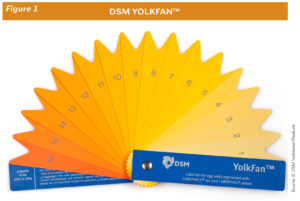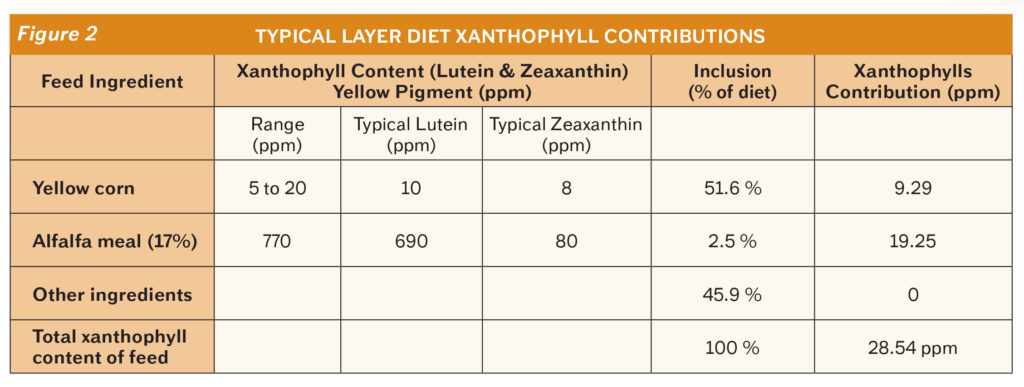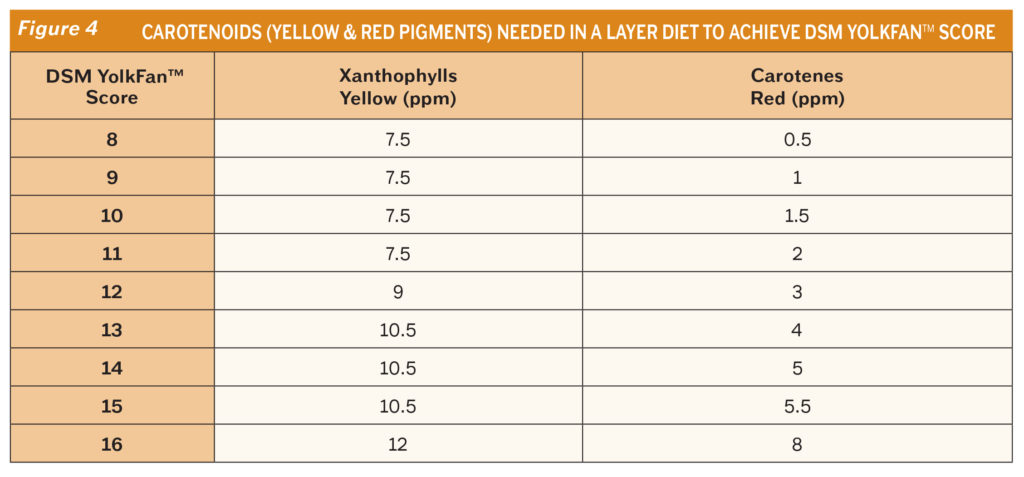Egg Yolk Color And How To Manage It
Click here to view as a pdf: Egg Yolk Color And How To Manage It
Food color and presentation matter. Color is an important sensory factor that helps consumers determine food quality and its potential health benefits. Richly colored egg yolks, for example, can only come from healthy layers that have been fed a well-balanced, nutrient-rich diet. Hens need to be healthy enough to convert their diet properly in order to pass critical nutrients into the egg (primarily the yolk). Egg yolks are an excellent source of key nutrient-dense compounds such as proteins, fats, minerals, vitamins, antioxidants and trace minerals that are essential to our good health. Consumers associate a strong yolk color with a healthy, nutrient-rich food. There is a growing market demand for eggs with rich yolk coloring.
Darker/richer yolk coloring happens when layers eat a diet that contains high levels of powerful carotenoid antioxidants and are healthy enough to process the diet properly. The birds take the carotenoids from the diet and transfer the antioxidants to the egg yolk. The higher levels and specific combinations of key carotenoids provided to the bird will result in a richer, golden colored egg yolk, along with higher levels of antioxidants. These darker colored egg yolks can be typically found with small family flocks, where the layers are able to forage on carotenoid-rich plant material to supplement their diet. In today’s more commercialized egg production however, the birds may have limited, or no access to free choice green plant material. Consequently, concentrated forms of key carotenoids need to be strategically added to the layer diet in order to enrich the egg yolk with these important antioxidants. This will result in the golden colored, antioxidant-rich egg yolk that consumers desire.
How To Measure Egg Yolk Color
 The options for measuring egg yolk color are as follows1:
The options for measuring egg yolk color are as follows1:
- HunterLab Scale: An objective analysis that measures lightness, redness, and yellowness with mechanical equipment such as a colorimeter that expresses color according to the HunterLab Scale.
- DSM YolkFan™ Color Scale (Figure 1): Has a fan of color strips numbered from 1 to 16 with colors ranging from 1 being a very pale yellow up to the 16 being a dark orange color. This is a subjective method, but is very popular and is referenced commonly around the world.
- Spectrophotometry: Determines the carotenoid content as beta-carotene equivalent standardized method (BCE), i.e. the iCheck Egg method. Typically used for colors over 16 on the DSM scale and is very accurate.
A typical target egg yolk color on the DSM Color Fan, for good consumer acceptance, is a score of 7.
What Affects Egg Yolk Color
Carotenoids: The color of an egg yolk is directly related to the amount and types of carotenoids in the layer’s diet. There are over 1,100 known carotenoids which are antioxidant pigments found in plants, algae, and photosynthetic bacteria. Carotenoids can be categorized into two classes of compounds based on differing chemistry and pigmentation. They are carotenes and xanthophylls.3
- Carotenes (contain no oxygen): are a yellow or red pigment found in dark green, leafy, and yellow vegetables such as collards, turnips, carrots, sweet potatoes, squash, yellow fruit, milk, egg yolk, and body fat. Carotenes can be converted into vitamin A in the body.
- Xanthophylls (contain oxygen): are yellow pigments found in the leaves of most green plants. There are a number of different xanthophylls, two, in particular, are important to yolk coloring: lutein and zeaxanthin. Both lutein and zeaxanthin are important in the human diet. One example is that they support healthy retina tissue in the eye and reduce the risk of macular degeneration.
Some ingredients used in poultry nutrition can have significant levels of xanthophylls (Figure 2 and Figure 3)3,4.
Figure 2 shows a typical layer diet with yellow corn as the primary energy source, using typical estimates of xanthophyll (yellow color) levels in the corn, results in a strong score of 9.29 ppm of xanthophylls in the layer feed. The addition of 50 lbs. per ton of alfalfa meal not only addresses the fiber need for the birds, but it also contributes a significant level of xanthophylls to the egg yolk. Even though the corn/alfalfa diet would result in a bright yellow yolk and not an orange color; the yolk still contains an excellent amount of xanthophyll. If a more orange/golden color yolk is desired, a certain amount of carotene (red pigment) needs to be added in addition to the yellow-colored xanthophyll sources.
Strategies To Achieve Darker, Orange Egg Yolk Color
Another key principle to consider when targeting a specific egg yolk color is the fact that both yellow and red pigments are needed to achieve colors above a DSM YolkFan™ score of 7. The first component to pigmenting an egg yolk is the ‘saturation phase’, which involves depositing enough yellow pigments (xanthophylls) to reach at least a DSM YolkFan™ score of 7. This yellow (base saturation phase) is needed in order for the second phase application of a red pigment (carotenes) to be more efficient in achieving the richer golden colors indicated by higher numbers of the DSM YolkFan™ (Figure 4).3 Feeding extreme levels of yellow pigment can result in a very nutrient-rich yolk with excellent yellow color, but this color may only score a 7 or 8 on the DSM YolkFan™ scale. To more effectively move the yolk color higher on the DSM YolkFan™ scale, a red pigment needs to be added to the yellow base saturation. A good analogy would be the color combinations necessary to achieve green colored paint. It requires both yellow and blue colors. Extreme levels of yellow will never accomplish a green. Blue needs to be added to the yellow. If the yellow level is too low, the blue will fail to make the desired green as well.
A custom strategy can be developed for any particular barn to increase yolk color, depending on the many variables that a given producer is experiencing, i.e. variability of dietary ingredients, the health status of the birds and their digestive tract, stress level and/or nutrient blocks like high iron water or mycotoxins.
What are some good sources of carotene (red pigmentation) that can be added to the layer diet? Paprika powder is a good source of carotene/red pigmentation and is allowed to be added to layer and broiler diets by the Food and Drug Administration (FDA) and the Association of American Feed Control Officials (AAFCO). However, the carotenes in paprika are very unstable, and therefore need to be protected from oxygen exposure in order to maintain good shelf life. Commercial products like Kem-Glo™ contain paprika, but this product needs to be stabilized (protected from exposure to oxygen) as well in order for it to effectively accomplish higher yolk color goals. Raw paprika can readily lose significant levels of carotenoids (50 to 75%) when exposed to air, resulting in the need for higher inclusion rates per ton. Even if straight paprika is used, and assumed to be 100% stable and effective (a doubtful scenario) it would take over 3 lbs. of paprika to provide 0.5 ppm of carotene in a ton of layer feed. Going up the scale of color in Figure 4 demonstrates that to achieve a level of 1 ppm of carotene would require over 6 lbs. of paprika to be added to the diet (again assuming 100% efficacy). The inclusion rates can go up even more significantly if the product is compromised and the active ingredient is lost. As you can see the additional expense of adding yolk coloring ingredients to the layer’s diet begs the question; Is there an appropriate premium paid for the eggs to provide the necessary return on the investment to justify the added expense of adding the xanthophylls and carotenes to the feed3?
Other Factors That Can Negatively Affect Egg Yolk Color
Once the diet is properly formulated to attain the targeted egg yolk color, there are still some potential obstacles to accomplishing the desired color goal. The issue of having a healthy bird is the underpinning of good nutrient utilization, including the carotenoids. Two questions should be asked when designing any livestock diet: 1) Is this a good diet? 2) Can the animal use the diet? These questions highlight the main areas of consideration when working with livestock nutrition to achieve efficient production. The following challenges can reduce the bird’s ability to effectively use the diet and compromise the productivity of the birds. Any of these topics can also impede yolk coloring efforts as well.
- Stress: heat stress, cold stress, crowding, piling, poor handling, and nutritional challenges.
- Mycotoxins: possess the capability to reduce organ function, irritate intestinal tissue, damage liver tissue, compromise immune function and tie up nutrients.
- Poor digestive function: digestive tract environment disruption due to infections, mycotoxins or stress.
- Reallocation of nutrients: low vitamin A availability will convert carotenoids to vitamin A.
- Disease: infections can reduce feed efficiency and compromise bird health, i.e. E. coli, Salmonella, Clostridium.
- Poor water quality: high iron and/or high sulfur in water lowers feed efficiency and challenges immune status.
- Poor sanitation: high pathogen load in the waterline and equipment can jeopardize bird health.
- Poor ventilation: respiratory/bronchitis challenges threaten immune function.
- Compromised immune function: can reallocate carotenoids to the bird’s survival needs and lower the deposit of carotenoids into the yolk.
- Lighting: directly impacts feeding behavior, feed intake, utilization, and production.
- Abnormal intake: both extremes of low and high daily feed intake may disrupt nutrient deposits in the egg as well as yolk color.
There are effective tools available to help achieve a desirable egg yolk color. Work closely with a Crystal Creek® nutritionist to develop a plan that is best for your operation to help reach your production, egg yolk color, and profitability goals.




